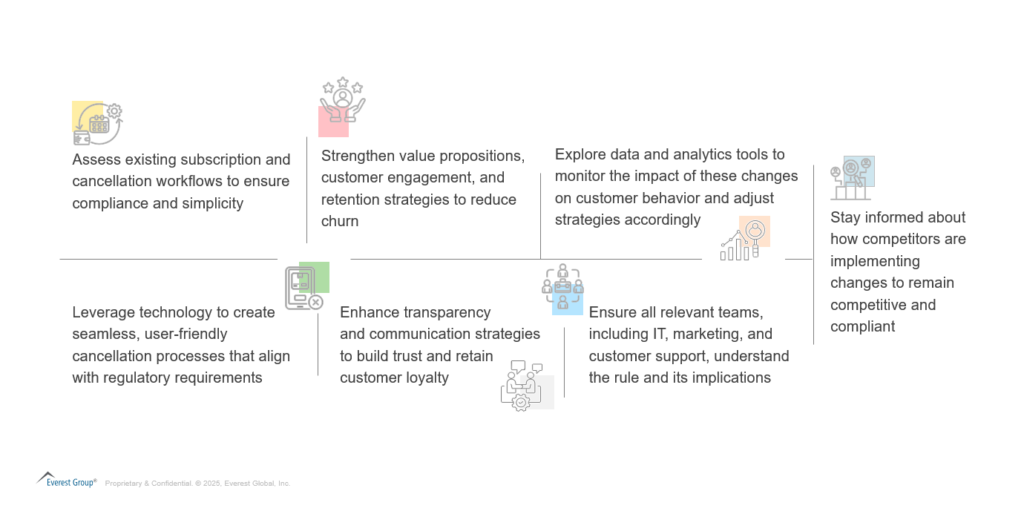
The introduction of the “click-to-cancel” rule by the Federal Trade Commission (FTC) represents a pivotal and transformative development in the evolving landscape of Customer Experience Doc 3 (CX) in the modern era.
Set to take effect in mid-2025, click-to-cancel regulation aims to simplify the cancellation process for recurring subscriptions, having significant implications for both consumers and enterprises. This new regulation is a response to growing concerns about consumer rights and business practices, that make it challenging to opt out of subscription-based services.
For enterprises, understanding the wider implications of click-to-cancel rule is critical—not only to ensure compliance, but also to seize the opportunity to strengthen customer relationships and foster trust in an increasingly competitive marketplace.
Reach out to discuss this topic in depth.
What Is the “click-to-cancel” rule?
The click-to-cancel rule mandates that enterprises operating subscription models, including services with automatic renewals, continuity programs, and free-to-pay conversions, must implement a seamless and straightforward cancellation process, as simple as the process used to sign up for them.
For example, if a consumer signs up for a service online, they must be able to cancel it online without requiring phone calls or additional hurdles. This regulation aims to protect consumers from being trapped in unwanted subscriptions and aligns with broader efforts to uphold consumer rights and prevent deceptive practices in the subscription economy.
In addition to simplifying the cancellation process, the regulation introduces several key provisions that significantly impact CX, including:
- Notice of subscription terms: Enterprises must clearly disclose the terms of their subscription services before obtaining billing information and clearly outline all components of the bundled service
- Prohibition of retention tactics without consent: Enterprises must obtain explicit consent before charging consumers, even after a free trial. They cannot use aggressive retention tactics, force multiple offers or prompts unless the consumer opts in
- Continuous reminders for services: The regulation requires enterprises to send periodic reminders about renewals or upcoming charges, ensuring customers stay informed and can make timely subscription decisions
- Marketing with disclaimers: Enterprises must avoid manipulative tactics that hinder cancellations or changes. For enterprises in the CX industry, all marketing must include clear disclaimers about the services being offered
While this regulation is being introduced in the U.S., its impact is expected to be global, pushing international firms to update their processes. Companies like Netflix, Disney, and Meta are attempting to block the rule, highlighting the broader industry resistance.
However, as this regulation sets a precedent, global enterprises may need to rethink their customer retention and cancellation strategies, in order to stay ahead of evolving consumer protection standards.
Implications of click-to-cancel for enterprises and consumers
This regulation reshapes business-consumer interactions, redefining expectations and transparency in the evolving CX landscape.
Consumer impact:
- Enhanced convenience and control: Consumers will gain greater autonomy over their subscriptions, with simplified cancellation processes reducing frustration
- Reduced financial losses: By preventing “dark patterns” and hidden charges, the consumers will be able to safeguard themselves from unintended renewals and unnecessary expenses
- Improved trust: With a transparent cancellation process, consumers will feel more confident to subscribe to services, leading to an overall increase in trust and long-term customer satisfaction.
- Higher expectations of CX standards: Consumers will increasingly demand seamless, transparent, and hassle-free digital interactions, not just for cancellations, but across the entire customer journey too
Enterprise impact:
Operational changes
- Platform adaptations: Enterprises will need to invest in developing and implementing user-friendly, intuitive cancellation interfaces for online platforms
- Account management: A proactive approach to account management is essential. Teams will need to monitor customer satisfaction more closely and address issues before customers feel the need to cancel
- Focus on value-driven experiences: With frictionless cancellations, enterprises will need to focus on delivering continuous value and transparent, customer-centric retention strategies. This includes clear disclosures, consent, and disclaimers in all user-facing content
- Agent training: Training agents to handle cancellation requests effectively, shifting from retention-at-all-costs tactics to empathetic and making sure no manipulative practices are at play
Financial implication
- Platform adaptation cost: The apps, website and CX platforms used by the enterprises must be redesigned to adapt to the new requirements with updates such as easy-cancellation and disclosures
- Compliance cost: Enterprises that fail to align with the new regulation may face penalties, adding legal and compliance challenges to their operational priorities
- Agent training costs: Enterprises will need to invest in training and development programs to ensure agents comply with the regulations
- Potential revenue loss: Easier cancellations could lead to an increase in churn rates, impacting subscription revenue streams, especially for businesses reliant on “negative option” models
The “Click-to-Cancel” regulation will have varying impacts across industries as well, depending on their reliance on subscription models and the complexity of their customer engagement processes. The exhibit below is a detailed breakdown of the impact across industries:

How enterprises should prepare now for the rule
The rule aims to simplify life for consumers, not complicate it for businesses. Avoiding compliance through shortcuts is not the answer. Instead, there is a focus on enhancing customer experiences, by taking the steps highlighted in the exhibit below, which can drive rewards without impacting revenue:

How can BPS providers help?
Business Process Services (BPS) providers can help enterprises comply with new regulations by streamlining cancellation workflows, designing retention strategies that balance compliance with customer engagement, and minimizing churn through proactive value-driven interactions.
Service providers can also support enterprises in regulatory compliance and CX strategy refinement by conducting workflow audits, optimizing subscription policies, and providing employee training on compliant customer interactions.
What the future holds post ruling? :
This regulation represents a positive, consumer-first development in the evolving landscape of CX. This regulatory shift encourages transparency, fairness, and the prioritization of customer satisfaction—principles that are increasingly becoming the foundation of effective business strategies, leading to more customer centric business models evolution.
Enterprises that embrace these changes and adapt their processes accordingly will not only remain compliant, but also foster deeper, more genuine relationships with their customers. BPS providers that take a proactive approach in engaging with enterprises—helping them navigate these changes, optimize their CX strategies, and implement seamless compliance solutions—will position themselves as strategic partners rather than just service vendors.
If you found this blog interesting, check out our The Top 10 Predictions That Will Revolutionize CXM in 2025 | Blog – Everest Group, which delves deeper into another topic regarding CXM.
To discuss this new rule in more depth or other topics relating to our Experience, Sustainability & Trust Service Line, please contact Rakshit Hooda ([email protected]), Uday Gupta ([email protected]) and Divya Baweja ([email protected]).










